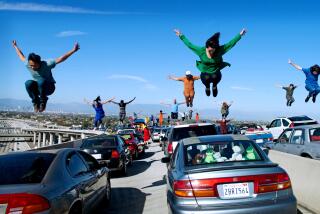Monumentally Appealing : L.A. Architecture Has Made a City Full of Creativity, Daring and Impudent Fun
THOUGH LOS ANGELES has long been denigrated as a wasteland, it is, as architecture critics have only recently come to realize, an architectural wonderland.
This is dramatized in “Keep It Up, L.A.,” a slide show written by Julian (Bud) Lesser and Marjorie Fasman for the L.A. Conservancy.
A “history of Los Angeles in 15 minutes,” the show dramatizes the “magical” transformation of Los Angeles from a desert into an “enchanted” city.
One image after another flashes on the screen, beginning with animals trapped in the La Brea tar pits (the first preservation) and ending with a mirrored skyscraper.
Not neglected in this pictorial panorama are the “programmatic” buildings--the “roadside vernacular architecture” that has provoked so much critical abuse of the city.
Among these are the Sphinx realty office, the Van de Camp windmill bakery, the Assyrian tire factory, the big red piano store, the Tail-of-the Pup hot-dog stand, the drive-in doughnut hole, the Brown Derby.
Pure kitsch, of course, but somehow these structures that symbolized the businesses they housed were exuberant expressions of the city’s entrepreneurial spirit, its conviction that commerce could be fun under the sun.
Not included are numerous other examples of this genre--including the twin-engine airplane that used to be Bob’s gasoline station at Wilshire and Cochran, the lighthouse realty office on Hollywood Boulevard, the coffeepot coffee shop--also on Wilshire, the chili bowl on Crenshaw, the igloo on Pico and the Hoot Hoot I Scream ice-cream shop, in an owl, in South Gate.
They began in the 1920s, that age of wonderful nonsense, and proliferated during the Depression, when people seemed to enjoy a laugh. I believe a few of them still exist.
The next phase of L.A. fantasy in architecture was executed on a grander scale. We imitated the ancient monuments of other cultures and produced the Mayan Theater on Hill Street, Grauman’s (now Mann’s) Chinese Theater and the Egyptian Theater in Hollywood, the Los Angeles Theater on Broadway, with its Louis XIV lobby, UCLA’s Romanesque Royce Hall and the Beaux Arts Biltmore Hotel.
Also shown are some famous landmarks that have vanished from the landscape: the Alligator Farm, the Ostrich Farm, the Venice canals (when they still had gondolas on them).
Represented, too, are those residences in the Hollywood Hills that were made to resemble Egyptian tombs, Chinese pagodas, Moorish mosques, Greek temples. It was of these that Nathanael West wrote: “But not even the soft wash of dusk could help the houses. Only dynamite would be of any use against the Mexican ranch houses, Samoan huts, Mediterranean villas, Egyptian and Japanese temples, Swiss chalets, Tudor cottages and every possible combination of these styles. . . .”
Our true glory, though, is in our museum of Art Deco and art moderne buildings, of which, thanks in part to the conservancy, a number still stand, and in the many residences designed by architects drawn here by the light and the salubrious climate--John Lautner, Richard Neutra, R. M. Schindler, Frank Lloyd Wright. (Architects like good weather, too.)
Among the treasures rescued by the conservancy is the zigzag moderne Wiltern Theater, which stands today, renovated, like a flagship of the Art Deco and art moderne era. Also still standing, incredibly, are the Eastern Columbia Building (Broadway at 9th) and the Art Deco Bullocks Wilshire.
Some of them, of course, are gone. Among the missing are the Carthay Circle Theater, home of the most excessive Hollywood premieres, and the Philharmonic Auditorium, where Los Angeles got its culture before the Music Center era.
The show’s message is that this “magical city” was created by people of energy, vision, talent and luck.
The message I read in it is that we need not apologize for the city we have built. With all its faults, it is still a wonderland of creativity, daring and impudent good fun.
But keep your eye on the Ambassador Hotel. And whatever happened to Angel’s Flight?
More to Read
The biggest entertainment stories
Get our big stories about Hollywood, film, television, music, arts, culture and more right in your inbox as soon as they publish.
You may occasionally receive promotional content from the Los Angeles Times.










